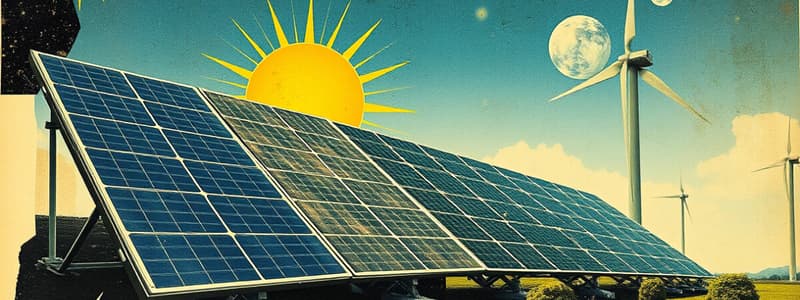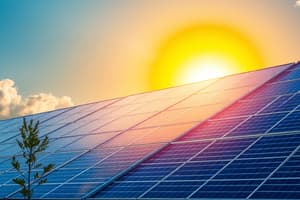Podcast
Questions and Answers
What occurs during primary succession?
What occurs during primary succession?
- Immediate colonization by a diverse range of species.
- Complete replacement of species after disturbances like volcanic eruptions. (correct)
- Fast recovery of vegetation after a disturbance.
- Ecosystem stability without any disturbances.
How can introduced species impact ecosystems?
How can introduced species impact ecosystems?
- They promote biodiversity by coexisting with native species.
- They can cause local extinctions and disrupt ecological balance. (correct)
- They thrive in any environment regardless of other species present.
- They create a more competitive environment for native species.
Which statement about biomes is true?
Which statement about biomes is true?
- Aquatic biomes are nutrient-rich and support diverse wildlife.
- Tundra biomes have a long growing season and abundant vegetation.
- Deserts are known for having warm climates with minimal rainfall. (correct)
- Taigas are characterized by a variety of tree species and rich soil.
What role do pioneer species play in ecological succession?
What role do pioneer species play in ecological succession?
What is the primary function of nitrogen-fixing bacteria in ecosystems?
What is the primary function of nitrogen-fixing bacteria in ecosystems?
What is the greenhouse effect primarily caused by?
What is the greenhouse effect primarily caused by?
Why do different parts of Earth experience different seasons?
Why do different parts of Earth experience different seasons?
How is wind generated on Earth?
How is wind generated on Earth?
What causes global warming?
What causes global warming?
What occurs on the first day of summer?
What occurs on the first day of summer?
How does the sun affect climate and weather?
How does the sun affect climate and weather?
What is the main mechanism by which solar energy transforms to heat energy on Earth?
What is the main mechanism by which solar energy transforms to heat energy on Earth?
What role does the sun play in the water cycle?
What role does the sun play in the water cycle?
Which method of heat transfer involves the direct contact of molecules?
Which method of heat transfer involves the direct contact of molecules?
What is the primary difference between weather and climate?
What is the primary difference between weather and climate?
How does warm air affect air pressure?
How does warm air affect air pressure?
What is the effect of the Coriolis Effect on wind direction?
What is the effect of the Coriolis Effect on wind direction?
What happens to air as it rises over a mountain?
What happens to air as it rises over a mountain?
Which of these materials is considered a good conductor of heat?
Which of these materials is considered a good conductor of heat?
What primarily generates wind?
What primarily generates wind?
What defines adiabatic processes?
What defines adiabatic processes?
What type of cloud is associated with thunderstorms and severe weather?
What type of cloud is associated with thunderstorms and severe weather?
Which of the following best describes a cold front?
Which of the following best describes a cold front?
What phenomenon describes the rise of warm, humid air that leads to cloud formation?
What phenomenon describes the rise of warm, humid air that leads to cloud formation?
Which wind cell is found between the Polar and Hadley cells?
Which wind cell is found between the Polar and Hadley cells?
What can result when two air masses with different temperatures collide?
What can result when two air masses with different temperatures collide?
What term describes a mass of air that retains the characteristics of its area of origin?
What term describes a mass of air that retains the characteristics of its area of origin?
Which type of front results in rainy weather lasting for several days?
Which type of front results in rainy weather lasting for several days?
What are the characteristics of the doldrums?
What are the characteristics of the doldrums?
What determines weather conditions and types of clouds that may form during frontal boundaries?
What determines weather conditions and types of clouds that may form during frontal boundaries?
At what levels can ecology be studied?
At what levels can ecology be studied?
What is the primary focus of community ecology?
What is the primary focus of community ecology?
What characterizes a food web?
What characterizes a food web?
What does carrying capacity refer to?
What does carrying capacity refer to?
Which type of symbiotic relationship benefits one organism while neither helping nor harming the other?
Which type of symbiotic relationship benefits one organism while neither helping nor harming the other?
What percentage of energy is typically transferred between trophic levels in an ecosystem?
What percentage of energy is typically transferred between trophic levels in an ecosystem?
What type of mimicry occurs when a harmless organism mimics the warning coloration of a harmful species?
What type of mimicry occurs when a harmless organism mimics the warning coloration of a harmful species?
Which term describes the pattern where organisms are equally distanced from one another due to competition for resources?
Which term describes the pattern where organisms are equally distanced from one another due to competition for resources?
How do predators and prey influence each other's evolution?
How do predators and prey influence each other's evolution?
What is the main role of producers in an ecosystem?
What is the main role of producers in an ecosystem?
What is the relationship called when one organism lives inside another organism?
What is the relationship called when one organism lives inside another organism?
Study Notes
Solar Energy and Its Impact
- Solar energy warms the Earth and drives climate, weather, and seasonal changes.
- The greenhouse effect occurs when some solar energy is absorbed and some is trapped by greenhouse gases, essential for sustaining life.
- Too much greenhouse gas can lead to global warming and climate change.
- Earth's axial tilt causes varying sunlight distribution, resulting in opposite seasons across hemispheres.
- Solstices mark the start of summer and winter, while equinoxes denote spring and fall.
Wind and Heat Transfer
- Wind is created by uneven heating of the Earth, resulting in low and high-pressure areas.
- Air moves from high-pressure zones to low-pressure zones, causing wind.
- Convection currents transfer heat through fluids, elevating warm air while cooler air sinks.
- Radiation transfers heat via electromagnetic waves, requiring no medium.
Weather vs. Climate
- Weather refers to short-term atmospheric conditions, including humidity, temperature, and precipitation.
- Climate represents long-term average weather patterns in specific areas, affecting ecosystems.
- Incremental weather changes can lead to significant climate shifts and environmental impact.
Air Pressure and Its Dynamics
- Air pressure results from molecular collisions and is influenced by temperature and density.
- Warm air expands and holds less moisture, often leading to rain when it cools and condenses.
- The pressure gradient force and the Coriolis Effect dictate wind speed and direction but are influenced by surface friction.
Atmospheric Circulation
- Atmospheric circulation involves the movement of air molecules, helping redistribute heat and weather globally.
- There are three major types of wind cells: Polar, Ferrel, and Hadley Cells, affecting temperature and weather patterns.
- Fronts form when air masses with differing temperatures and humidity collide, often causing storms.
Types of Air Masses
- Air masses take on characteristics from their formation regions, classified into six types based on their origins.
- Movement of air masses affects local weather conditions, and transitions create frontal boundaries.
Cloud Formation
- Clouds form through convectional and orographic lifting, as well as when air masses collide.
- Different types of clouds and storms arise based on front types, influencing weather conditions.
Weather Fronts
- Weather fronts represent boundaries between different air masses, influencing precipitation patterns and storm intensity.
- Cold fronts are associated with thunderstorms, while warm fronts bring gray skies and light rain.
Ecology Overview
- Ecology is the study of interactions between living organisms and their environments, ranging from individual organisms to global biospheres.
- Various ecological levels include organismal, population, community, ecosystem, and biosphere ecology.
Food Chains and Food Webs
- Food chains depict linear energy flow among organisms, while food webs illustrate complex interconnections within ecosystems.
- Producers occupy the base of the trophic pyramid, followed by various consumer levels.
Predator-Prey Dynamics
- Predation drives coevolution, fostering adaptations in both predators and prey for survival.
- Camouflage, chemical defenses, and mimicry are common adaptations for evasion and predation.
Symbiotic Relationships
- Symbiosis encompasses various relationships where at least one organism benefits, including mutualism, commensalism, and parasitism.
Carrying Capacity and Population Dynamics
- Carrying capacity is the maximum population size an ecosystem can sustain based on available resources.
- Population growth follows an exponential pattern until it reaches carrying capacity, leading to stabilization.
- Dispersion patterns include uniform, clumped, and random, influenced by resource availability and competition.### Migration and Ecological Succession
- Migration refers to periodic movement of populations primarily to access food resources.
- Ecological succession involves gradual replacement of plant species after environmental disturbances.
- Primary succession follows geological events like volcanic eruptions and glacier retreats, eliminating topsoil.
- Secondary succession occurs after disturbances like fires or floods, leaving topsoil intact for regrowth.
- Pioneer species are the first to repopulate after a disturbance; they are usually hardy primary producers.
- As biodiversity increases, resource competition intensifies, shaping plant community dynamics.
- Climax communities reach a state of ecological stability, characterized by minimal resource competition but are not permanent.
Introduced and Invasive Species
- Introduced species are those not native to an environment, brought by human activity.
- If introduced species aren't adapted to their new surroundings, they may die out; if they survive, they can reproduce and alter local ecosystems.
- Invasive species can lead to local extinctions by disrupting ecological balance.
- Many invasive species thrive in new habitats due to absence of their natural checks, often leading to ecological or economic harm.
Biomes
- Biomes, or major life zones, are characterized by soil, climate, wildlife, and vegetation.
- Major biomes include desert, aquatic, tundra, grassland, and forest, with subcategories such as temperate grasslands and savannas.
- Taigas have cold climates and nutrient-poor soils, dominated by coniferous trees.
- Tundra biomes display extremely cold conditions and are tree-less; include Arctic and Alpine tundras.
- The open ocean, representing 65% of the planet, is productive yet nutrient-poor and supports limited life.
- Estuaries serve as crucial habitats for marine life where freshwater meets saltwater but are threatened by pollution.
Nutrient Cycles and Environmental Impact
- Nitrogen fixation transforms atmospheric nitrogen into ammonia, which is usable by plants.
- Nitrification converts ammonia to nitrite and then to nitrate, essential for plant growth.
- Eutrophication occurs when excess nutrients lead to algal blooms in aquatic systems, causing hypoxia.
- Acid rain results from sulfur and nitrogen oxides reacting with water; can lower pH levels in sensitive ecosystems.
- Acid rain can have detrimental effects on aquatic life and contribute to deforestation in vulnerable areas.
Studying That Suits You
Use AI to generate personalized quizzes and flashcards to suit your learning preferences.
Description
This quiz covers the various ways solar energy influences our planet. It highlights the relationship between the sun's energy, climate, weather patterns, and the greenhouse effect. Understanding these concepts is crucial in recognizing the importance of solar energy for life on Earth.




